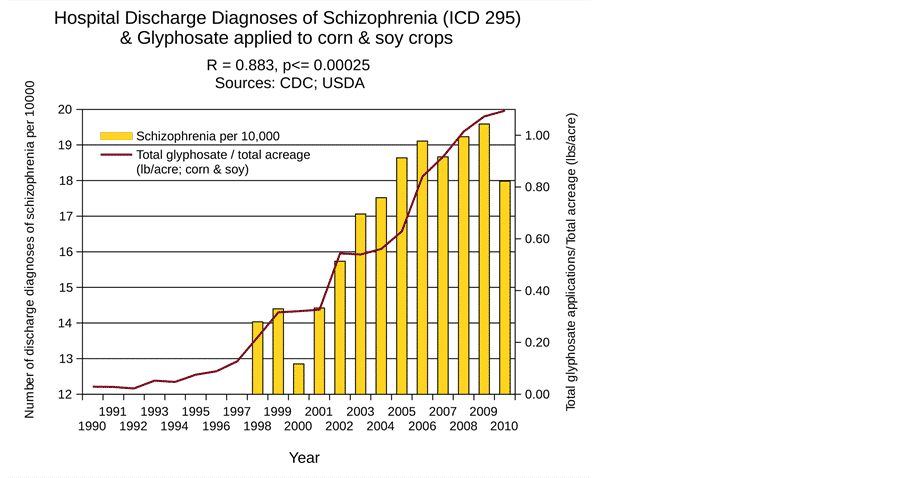Healing Journey Insights & Tools
Glyphosate And its Effects on the Body: A Review of Dr Seneff’s Work
The chemical has not been well studied. As its usage has increased, so has the use of og genetically engineered crops that resist pesticides, specifically Round-Up Ready. Epidemiological data available from U.S. government sources show a remarkably strong correlation between glyphosate application to soy and corn crops and multiple neurological disorders.
Concerning Round-Up ready’s claims:
While correlation is not causation, the trends are very revealing and troublesome. Glyphosate works synergistically with aluminum, which is present in certain foods, vaccines, and water, to induce neurological damage.
Monsanto asserts that in vivo studies show Round-Up is non-toxic to animals. There are two primary problems with this assumption:
- The studies were far too short for reliable results. They were conducted for three months on average.
- The studies were conducted with pure glyphosate without the combination of fillers contained in Round-Up. These adjuvants include polyethoxylated alkylamines (POEAs), which is known to be extremely toxic on its own and can synergistically increase the toxicity of Glyphosate by 125 fold!
These authors wrote ([39] Abstract, p. 1): “Despite its reputation, Roundup was by far the most toxic among the herbicides and insecticides tested”.
It is harmful to humans because it disrupts the Shikimate pathway that is present in our gut bacteria, which uses the Shikimate pathway to make essential nutrients that our own cells cannot produce. This includes many amino acids, which are found to be extremely low in Autism and Alzheimer’s cases. (1)
One important study which echoes these results was conducted by Gilles-Eric Seralini. Unfortunately, the study was retracted after publication. It showed rats fed GM soy and corn over their lifetime developed liver and kidney malfunctions as well as mammary tumors.
The controversy stemmed from the study sample size and other fraudulent allegations about how the research was conducted. However, considering the power and political pull that Monsanto has, I question the legitimacy of those claims.
Fortunately, another journal accepted and republished the study.

The gut-brain connection
More recent studies now link glyphosate to gut bacteria disruption. This is critical because a healthy gut microbiome with species like bacteroides and lactobacillus works in harmony with our body. However, if gut permeability increases, we see an increase in chronic conditions such as autoimmune disorders, depression, anxiety, psoriasis, eczema, and neurologic problems like dementia and autism.
The gut membrane becomes permeable from an imbalance of parasites or pathogenic bacteria working against our digestive system. For instance, a diet high in sugar and processed carbohydrates feeds pathogenic bacteria like Bacteroides Firmicutes, which alters the natural pH of the gut. An acidic pH triggers the release of digestive enzymes, which break down food for absorption. This leads to nutritional deprivation of vitamins, minerals, and antioxidants.
The vagus nerve connects the gut to the brain. The gut communicates to the brain more than the other way around. The bacteria in the gut directly impact our cravings, moods, weight loss or gain, and the efficiency of the immune system. In fact, 80% of your body’s immune cells are in the gastrointestinal associated lymphatic tissue (GALT). 90% of serotonin receptors are inside our intestines.
The neuroendocrine system, brain, and gut have a chemical language that is not fully understood by science yet. When the gut experiences disruption, immunity, digestion, sleep patterns, and mood experience disruption.
How do glyphosate and aluminum in Round Up impact neurological conditions? It’s through a critical organ that is connected to conditions like Parkinson’s, Alzheimer’s, autism, schizophrenia, anxiety, and depression. It is linked to spirituality, yoga, meditation. Ancient cultures referred to it as the “third eye.” It is the pineal gland.
The magical, but poorly understood pineal gland

Melatonin regulates sleep. The pineal gland releases melatonin at night. The pineal gland is a small pine cone-shaped organ that sits behind the optic chiasma. It is highly perfused with blood, second only to the kidney. This is interesting to me that such a small gland would need such a high amount of blood flow. We have long associated the pineal gland with sleep-wake, or circadian rhythm cycles, but new research is indicating that we have not fully understood this gland.
There have been some recently published articles that show Melatonin, related to melatonin, but is DMT-based, is produced in the pineal gland of rats. DMT is thought to be the molecule of consciousness, which links the pineal gland to a possible higher function than previously thought.
Interestingly, the pineal glands of those with Alzheimer’s are completely calcified. Approximately 40% of Americans have calcified pineal glands by age 17. By old age, the pineal gland has about as much fluoride as teeth do. Why does this happen? The blood-brain barrier does not protect the pineal gland from many toxins and heavy metals. Therefore, anything that enters our bloodstream will expose the pineal gland without much protection. This explains why it is especially susceptible to exposure to environmental toxins such as aluminum, fluoride, cadmium, and mercury. “A study on the neurological effects of occupational exposure to aluminum revealed sleep disturbance as a common complaint, with insomnia being reported in 22.4% of cases and sleepiness in 14.9%.”
The pineal gland has strong connections to neurological disorders and sleep disorders. Psychiatric and neurological disorders frequently disrupt sleep. In a Hong Kong study, researchers found psychiatric conditions were the strongest predictors of insomnia in both men and women. The pineal is likely involved in all of these conditions. In one study, the brains of the deceased were examined and aluminum was found in the pineal glands. It accumulates aluminum at a rate that is twice that of other brain regions.
How aluminum and glyphosate cause damage to the pineal gland and gut
This combination can harm your body along three different pathways. First, through interfering with the CYP450 detox enzymes that also help to make melatonin. Secondly, by causing anemia that leads to hypoxia (decreased oxygenation) which increases the effect of aluminum on neurons (brain cells). Thirdly, through impaired sulfate synthesis in the liver in combination with vitamin D interference.
That’s a lot of disruption. Let’s break it down.
Enzyme interference leading to disrupted melatonin and vitamin D deficiency
Heavy metals like aluminum and mercury are known neurotoxins. The Seneff paper shows how these two toxicants work together to induce neurological damage. Many studies show that Glyphosate disrupts the gut flora, which predisposes one to overgrowth from Clostridium Difficile. Better known in medical circles as C. Difficile, this nasty bug gives patients abdominal cramping, diarrhea, and nausea. It reproduces by spores and can only be killed by using soap and water, not hand sanitizers.
The most worrisome part is this bacteria is now being found outside of hospitals and in the community because our immunity is being lowered, in part due to Glyphosate. Both aluminum and glyphosate can enter the body together to cause major issues. Glyphosate chelates bind up aluminum. Then it can pass through the gut barrier and enter the bloodstream unchecked. This study also shows that both glyphosate and aluminum disrupt the cytochrome CYP450 enzyme, which is involved in many detox reactions and in melatonin synthesis.
P450 enzymes also help to breakdown medications, drugs, pesticides, and other toxins, but if inhibited, the likelihood that we will experience greater toxicity. The CYP enzymes are integral to making melatonin. So if we have glyphosate toxicity, we may be inadvertently harming our melatonin and therefore, our natural sleep patterns, leading to insomnia and impaired REM sleep.
“Pigs fed a diet of GM Roundup-Ready corn and soy suffered from an inflamed stomach, clearly suggesting gut dysbiosis. A leaky gut, associated with gastrointestinal disorders, will facilitate the passage of both Al- citrate and Al-glyphosate past the impaired tight junctions of the gut boundary. Glyphosate is a microbicide, and it preferentially kills beneficial gut bacteria allowing pathogens like Clostridium difficile to overgrow.”
Balanced gut flora regulates cravings, mood, and immunity
When glyphosate destroys the good gut bacteria, it promotes a breeding ground for pathogenic bacteria. Vitamin D deficiency is rampant in the USA, and it can be caused by interference with the CYP enzymes. The charts from this paper also relate the epidemic of vitamin D deficiency to the correlation of expanding use of Round-Up throughout the country.
CYP enzymes in the liver have a crucial role in maintaining the health of the intestinal crypts and the villi in the small intestine. The Seneff paper argues that CYP dysfunction in the gut and liver leads to the impaired supply of the neurotransmitters, serotonin, melatonin, and sulfate to the brain. It is postulated that celiac disease is caused partially by glyphosate as it causes CYP enzyme dysfunction as well.
Anemia and hypoxia
The by-product of the pathogenic bacteria and glyphosate breakdown is p-cresol, which is very toxic and linked to autism. Why? P-cresol can increase the uptake of aluminum via a receptor called transferrin. Aluminum can work synergistically with glyphosate, which I noted above. It can result in anemia, which can lead to decreased oxygen-carrying capacity, known as hypoxia.
Hypoxia increases the risks of aluminum’s effects on the neurons. This is also dangerous for the pineal gland as it needs high levels of blood flow. Anemia inhibits oxygen from getting to the pineal gland. Babies born with hypoxia due to preterm labor have a higher risk for autism because hypoxia increases aluminum uptake by the pineal gland. It’s a little like choking the pineal gland out; starving it of oxygen while introducing heavy metals that influence calcification.
Impaired sulfate synthesis caused by vitamin D deficiency.
Sulfate is an important element in phase 2 liver detoxification. In addition, it is a precursor to the master antioxidant, glutathione. It has long been known that children with autism have impaired sulfate synthesis. In fact, these children are missing some very important building blocks like methionine, glutathione, and cysteine.
Some researchers believe that glyphosate blocks the formation of these critical amino acids and gut bacteria. However, this is how humans obtain sulfate – from plants and bacteria. We are all connected intimately to bacteria. When we disrupt their natural systems, we may harm our own natural systems.
Furthermore, the CYP enzymes are necessary to activate vitamin D in the kidneys and liver. When aluminum and glyphosate create a barrier to vitamin D activation, this may be a culprit behind the vitamin D deficiency epidemic.
How is this deficiency in vitamin D related to sulfate? Well, studies show that vitamin D regulates the uptake of sulfate in the kidneys. When the receptor is defective or we are vitamin D deficient, we are not transporting sulfate into the cells in the small intestines and therefore, the brain, which affects the proteoglycans. Proteoglycans are necessary for healthy GI tract cells.
Experiments on mice with impaired vitamin D receptors found that they had lower blood levels of sulfates and were eliminating most of it out in their urine. If our GI tract is sick, then are our brains and immunity are typically impacted. In the brain, the pineal gland conjugates melatonin to sulfate before shipping it out. Vitamin D, tryptophan (used to make the happy neurotransmitter, serotonin), DHEA (the precursor to testosterone), and estrogen are all also sulfated when they are shipped out.
It’s extremely important for the body to be able to use sulfate. Sulfate may also be necessary for the body’s mechanism that rids it of toxic cellular debris, plaques, oxidized lipids, and old proteins. Can you see how important sulfate transport and utilization are throughout the entire body?
“In summary, evidence from multiple fronts suggests that sulfate insufficiency is a critical factor in neurological disease. A deficiency in vitamin D, which induces sulfate wasting through the kidneys, leads to it suppressed serotonin synthesis in the brain and excess serotonin synthesis in the placenta, both of which contribute to the pathology of autism in the fetus and the neonate. It has become very clear that Alzheimer’s is associated with calcification of the pineal gland, and with a sharply decreased synthesis of melatonin. When melatonin levels were measured postmortem in the cerebrospinal fluid (CSF) of 85 Alzheimer’s patients and 82 age-matched controls, it was found that CSF melatonin levels in the AD patients were only 20% of the levels found in the control subjects. This was equally true for early-stage Alzheimer’s as for late-stage. Those with two copies of the ApoE-4 marker for Alzheimer’s risk had even lower levels of melatonin than the other Alzheimer’s patients. Computer tomography (CT) was used to show that the amount of calcified pineal tissue in patients with Alzheimer’s disease was significantly more than that in either normal controls, patients with depression, or patients with other types of dementia.”
Although we know calcification can begin very early in life, it is clearly much worse in neurologic conditions, like Alzheimer’s. The pineal gland helps to make sulfate when properly functioning, but calcification has a significant negative effect on its ability to do so. Therefore, aluminum uptake will disrupt melatonin and sulfate synthesis needed to run many processes in the body that keep us well.
Discussion: “In this paper, we have developed the argument that a synergistic interaction between aluminum and glyphosate can lead to severe impairment of pineal gland function, and that this could explain the association of sleep disorder with a wide range of neurological diseases, and likely even help explain the related pathology of those diseases. We began by showing the remarkably strong correlations between glyphosate application to corn and soy in the US and sleep disorder, autism, ADHD, suicide, anxiety disorder, and dementia. We have shown how glyphosate could assist entry of aluminum into the general circulation through chelation, and how glyphosate would indirectly enhance aluminum absorption by the pineal gland via its induction of p-cresol synthesis by pathogenic gut bacteria. p-Cresol enhances aluminum uptake via transferrin, which is present in large amounts in the pineal gland, and in enhanced amounts under hypoxic stress conditions, induced by both glyphosate and aluminum. We have also discussed the important role of CYP enzyme dysfunction in disrupting vitamin D3 homeostasis and disrupting sulfuration and metabolism of melatonin. We have shown that vitamin D3 normally plays an important role in maintaining the health of the intestinal villi in the small intestine, and we have argued that part of its role may be to supply sulfate to the enterocytes. Serotonin is the sole precursor to melatonin, and serotonin itself is produced by EC cells in the intestinal villi from tryptophan, one of the three aromatic amino acids whose synthesis is disrupted by glyphosate, through its interference with the shikimate pathway. Since tryptophan is an essential amino acid, we depend upon supply from food sources and/or from our gut bacteria. Thus, it can be expected that glyphosate residues in the food crops introducing exposure to gut microbes would lead to deficiencies in tryptophan and therefore in serotonin and melatonin.”
I couldn’t have said it better than Dr. Seneff, so I’ll finish with her discussion quote. I hope you all can see how important it is to raise awareness on this topic. We should all be demanding honest and organic food for our families. We should be speaking out against biotech firms that seek profit over humanity. We should be looking at natural herbs and vitamins to help detox us from herbicides and pesticides.
Take care of yourself. You are your own best doctor.
REFERENCES:
- Séralini G-E, Clair E, Mesnage R, Gress S, Defarge N, 1, Malatesta M, Hennequin D, Spiroux de Vendômois J. Republished study: long-term toxicity of a Roundup herbicide and a Roundup-tolerant genetically modified maize. Environmental Sciences Europe 2014, 26:14.
- Seneff, S. , Swanson, N. and Li, C. (2015) Aluminum and Glyphosate Can Synergistically Induce Pineal Gland Pathology: Connection to Gut Dysbiosis and Neurological Disease. Agricultural Sciences, 6, 42-70. doi: 10.4236/as.2015.61005.
- Barker, SA. Front Neurosci. 2018 Aug 6;12:536. dos: 10.3389/fnins. 2018.00536. eCollection 2018. N, N-Dimethyltryptamine (DMT), an Endogenous Hallucinogen: Past, Present, and Future Research to Determine Its Role and Function.
Real Progress From
Real People
FREE CARE Plan eBOOK by Dr. Jess, MD.
This system mirrors Dr. Jess MD's steps with patients in her virtual clinic. It’s not a diagnosis, it’s a roadmap; a step-by-step process designed to help people restore function, remove roadblocks, and rebuild resilience.


